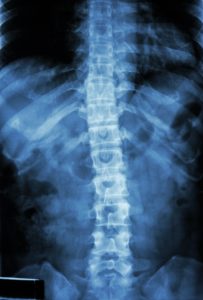
What is Multiple Myeloma
Myeloma bone disease involves focal areas of bone density loss and/or generalized loss of bone density. There are two major types of bone cells — osteoblasts which build new bone and osteoclasts which remove damaged bone. Under normal circumstances, there should be a balance between the osteoblasts and the osteoclasts. However, with myeloma, the osteoclasts are more active than normal and the osteoblasts are less active. This results in loss of bone density and in the development of lytic bone lesions (holes in the bones). These bone lesions can cause significant pain and can even result in fractures or spinal cord compression. Approximately 70-80% of myeloma patients will have bone lesions at time of diagnosis and almost all patients with myeloma will develop bone lesions during the course of their disease.
How is myeloma bone disease detected?
Historically, the screening test has been a series of x-rays called a “skeletal survey” or a “bone survey.” This test consists of x-rays of the skull, chest, spine, pelvis, arms, and legs to look for holes in the bones. Other tests which may pick up smaller bone lesions include CT scans, PET/CT scans, and MRIs.
How is myeloma bone disease treated?
The primary treatment involves bone-strengthening agents called bisphosphonates. If a bone is about to fracture or has fractured, then surgery can be required. For fractures in the spine, procedures such as kyphoplasty or vertebroplasty can be used. In cases where there is severe pain associated with a bone lesion and other methods of treatment have not been sufficient, radiation to the area may be required.
How do bisphosphonates work?
The bisphosphonates have an affinity for calcium and therefore are attracted to the calcium and calcium-containing substances in the bone. It is thought that the primary mechanism of action of the bisphosphonates is to suppress the activity of the osteoclasts. There are also data which suggest that bisphosphonates may have direct effects on the myeloma tumor cells as well.
How are bisphosphonates administered?
While many of the bisphosphonates that are used to treat osteoporosis are administered as pills, the two bisphosphonates which are used to treat myeloma bone disease (pamidronate and zoledronic acid) are both administered as intravenous infusions. Pamidronate is administered over at least two hours and sometimes over longer periods depending on the kidney function. Zoledronic acid is administered over 15 minutes, but the dosing must be adjusted based on kidney function and is not recommended for patients with severe kidney disease.
What are the side effects of bisphosphonates?
In general, the bisphosphonates used in the treatment of myeloma bone disease are well-tolerated. Some patients experience a flu-like reaction within 1-3 days of the first infusion which can include body aches, bone pain, fevers, and chills. Some patients may require the use of acetaminophen prior to and/or following the infusion if they continue to experience this reaction with subsequent doses.
What is osteonecrosis of the jaw?
Osteonecrosis of the jaw (ONJ) involves the development of an exposed area of bone inside the mouth. For some patients this can be associated with pain and swelling while others may not have any symptoms. Risk factors for developing ONJ include exposure to intravenous bisphosphonate therapy, pre-existing dental disease, radiation to the jaw, diabetes, and smoking. It is estimated that approximately 2% of cancer patients receiving intravenous bisphosphonate therapy develop ONJ. In order to minimize the risk of developing ONJ, my practice is to have my myeloma patients see their dentists prior to starting bisphosphonate therapy to make sure that there are no active dental issues which require treatment such as tooth extraction. In addition, patients should continue to see their dentists twice a year for careful monitoring. If any invasive dental surgery is needed, such as extractions or implants, then it is generally recommended that bisphosphonate therapy be held for 2-3 months prior to the surgery and 2-3 months after the surgery to allow for optimal healing.
How long should bisphosphonates be continued?
The bottom line is that we don’t know the right answer to this question. The International Myeloma Working Group (IMWG) guidelines suggest continuing treatment for two years and then discontinuing if patients are in a complete response or a very good partial response. For patients who have not achieved a partial response, the IMWG suggests continuing therapy beyond two years. My practice is to administer monthly bisphosphonate therapy for a year and then switch to every 3-month dosing for at least another year. The CALGB 70604 study compared monthly treatment of zoledronic acid to every 3-month dosing for 24 months in patients with metastatic breast or prostate cancer, or myeloma. Notably, the every 3-month dosing schedule resulted in the same numbers of skeletal-related events as the monthly dosing and there was a suggestion that there were fewer cases of ONJ. Although it is somewhat difficult to measure, there is evidence to suggest that the bisphosphonates stay in the bones for a very long time, perhaps even as long as 10 years, so additional studies are needed to determine the optimal dosing regimen.

Sarah Holstein, MD, PhD
Are there alternatives to bisphosphonates?
Denosumab is a drug which has been approved for the treatment of osteoporosis and for patients with solid tumor metastatic bone disease. It has not yet been approved for use in myeloma. However, a phase 3 randomized study was performed comparing denosumab to zoledronic acid in patients with newly diagnosed myeloma. Although the results have not yet been formally presented, it has been announced that there was no difference between the two treatment groups with respect to how long it took before patients developed a skeletal-related event. Therefore, denosumab appears to be as effective as zoledronic acid. Denosumab has a different mechanism of action from the bisphosphonates; it is a monoclonal antibody which binds to a substance called RANKL. RANKL is produced by osteoblasts and it activates osteoclasts. Therefore, by blocking the interaction of RANKL with its receptor on the surface of osteoclasts, denosumab decreases the activity of the osteoclasts. Denosumab is administered as a subcutaneous injection. Dosing does not need to be altered based on kidney function. Approximately 2% of patients treated with denosumab have experienced osteonecrosis of the jaw.
The information contained in this article is to be utilized for information purposes only. For specific questions regarding your medical condition or treatment plan please consult with your doctor directly. To schedule an appointment with a multiple myeloma specialist at Nebraska Medicine, call 800.922.0000.


